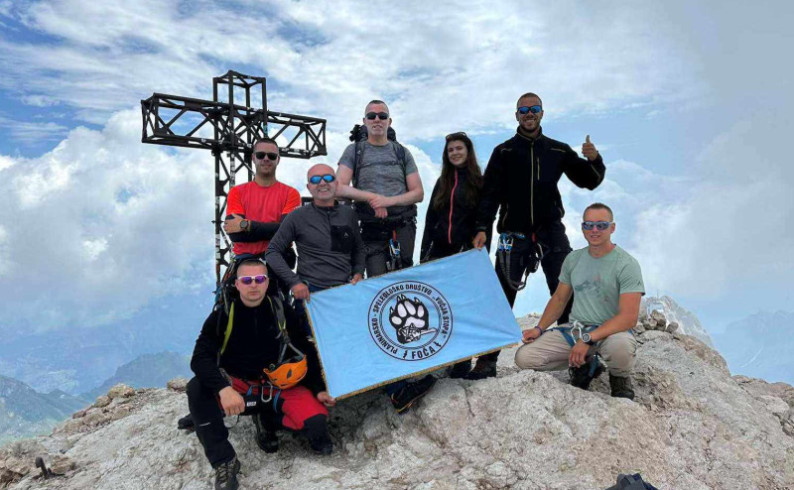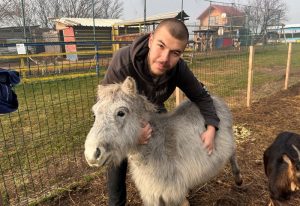Members of the “Wolf’s Foot” Mountaineering and Speleological Society from Foča successfully climbed the Alps, climbing three peaks, and in addition to the adrenaline-filled atmosphere and enjoyment of the stunning nature, this challenging expedition was also used for scientific and research work in the field of medicine.
The eight-day event, which took place at the end of July and beginning of August, began with the ascent to the Veliki Stol peak, 2,236 meters high, on the Karavanka massif in Slovenia, which was a warm-up and training for the next two much bigger challenges.

Top Veliki Stol in Slovenia
This was followed by an alpinist climb to the Mormolada massif in the Italian Dolomites, more precisely to the top of Punta Penia, at 3,343 meters, and then to the top of Kastor, under eternal snow and ice, on the border of Switzerland and Italy, which rises 4,226 meters above sea level.
The goal was to acclimatize and adapt to extreme weather conditions and thin air in the best possible way by gradually increasing the altitude.
Đorđe Vuković from Nevesin, a fourth-year student at the Faculty of Medicine in Foča, says that participating in the expedition to the Alps was a great privilege for him, because he has always dreamed of climbing to great heights.

“This was a dream come true for me and a big step out of my comfort zone. I climbed all three peaks, and I am most proud of the third because its altitude is 4,200 and as the Croats say, it was my first “four-thousand-thousander”, for me an unforgettable experience. From that place you can see all the peaks that you have always wanted to see, and I would highlight the Matterhorn peak, which was particularly beautiful to see,” says Vuković.
He added that they could not stay at the top for long because of the strong wind and low temperature.

Ascent to Kastor
Kastor was the most difficult peak, but he liked the Dolomites in Italy the most.
“In the Dolomites you can see everything – both the tame and the wild side. We climbed the Marmolada massif and its highest peak, Punta Penia, and that is perhaps one of the most memorable moments in this expedition,” adds Nevesinjac.
For him, as a beginner in alpinism, who has no experience with alpinist equipment, the ascent was, he believes, dangerous, but he was accompanied by the faithful members of the “Wolf’s Foot”, ready to selflessly share knowledge and experience.
“And to share that last chocolate bar from their pocket. It was a little scary, I have to admit, because it’s the first time I’m facing it, but I think I overcame it, I learned a lot about the Alps, how to use the equipment, how to move on the glacier, I broadened my horizons, I became mentally tough and I hope this is an invitation to some higher peaks”, says Vuković with enthusiasm and adds that he has found his new hobby, which is alpinism.

Marmolada
The new hobby was born, in fact, from his research work, because he participated in this expedition as a student researcher, with the task of examining the connection of cognitive abilities – thinking, memory, logical reasoning with high altitudes and the influence of acclimatization on the symptoms of acute altitude sickness.
The results are in the process of processing and will be published in a few months at one of the medical congresses or in one of the biomedical journals, but it can already be said that one of the results of this research is a large and positive impact of acclimatization on the prevention of symptoms of acute altitude sickness.
“We were able to achieve a level of adaptation for our body to adapt to the lack of oxygen, thanks to the fact that we had previously climbed the lower peaks and then climbed the highest peak with ease. Of the eight participants, six of us climbed to the highest peak, two participants gave up, while one participant had symptoms of acute altitude sickness, but despite these symptoms he continued, was persistent and pushed to the top,” says the student researcher.

At the top of Kastor, at 4,226 meters above sea level,
17-year-old Marija Lečić, a fourth-grade student at the Foča high school, was the youngest and only female member of this expedition.
“I climbed two peaks, I didn’t make it to the third, I had problems with my shoes, so I stayed at the base camp at 3,600 meters. On Marmolada, I was left partially without one gojzerica and I could not find a new one with which I could climb Kastor, but regardless, I am proud of myself and the rest of the team”, says Marija.
She started, she says, without high expectations, without burdening herself with fear, and she managed to deal with the altitude sickness she faced during the ascent to Marmolada.

“Sleeping at such a high altitude is extremely difficult and unusual, but it is a new experience that will remain as a memory for the rest of my life,” she points out.
For her, she adds, a special experience was the ascent to Marmolada in the Dolomites, where she experienced a lot of different alpinist techniques with the use of an ice ax – a mountaineering ice pick and crampons – a shoe accessory that enables walking on ice and glaciers.
“The ice has been broken and I am looking forward to new ascents and expeditions in the coming period,” said Marija.

In the base camp at 3,600 meters
The oldest participant in the expedition to the Alps, fifty-one-year-old Boban Andrić, says that the Veliki Stol in Slovenia was very demanding, although it was the only one without snow, because a large height difference of 1,100 meters had to be overcome, along with difficult movement on slippery terrain and gravel.
The ascent to the top of the Dolomites led over snow and glaciers along a very vertical path, and partly through rocks, and lasted about three and a half hours. However, the climb to the top of Kastor is a special story.

“It takes about four hours of good walking and climbing to get to the lodge, which is located at 3,600 meters. We slept there, got up early in the morning and reached the top at 4,200 in four hours, also along glaciers, snow and a vertical path. We used crampons, an ice ax, helmets, belts and a harness, you shouldn’t go without a harness, it’s a form of safety,” says Andrić.
From this society, they say that this expedition encouraged them to continue to strive for the most demanding peaks, while reminding that in the last eight years “Wolf’s foot” has conquered some of the highest mountains in Europe – Mont Blanc, Matterhorn, Gran Paradiso, Glos Grokner, Rilu , Olympus, as well as Pik Lenin in Kyrgyzstan.
Journalist: Igor Janković
Source: Radio Foča
Source: foca24.info





